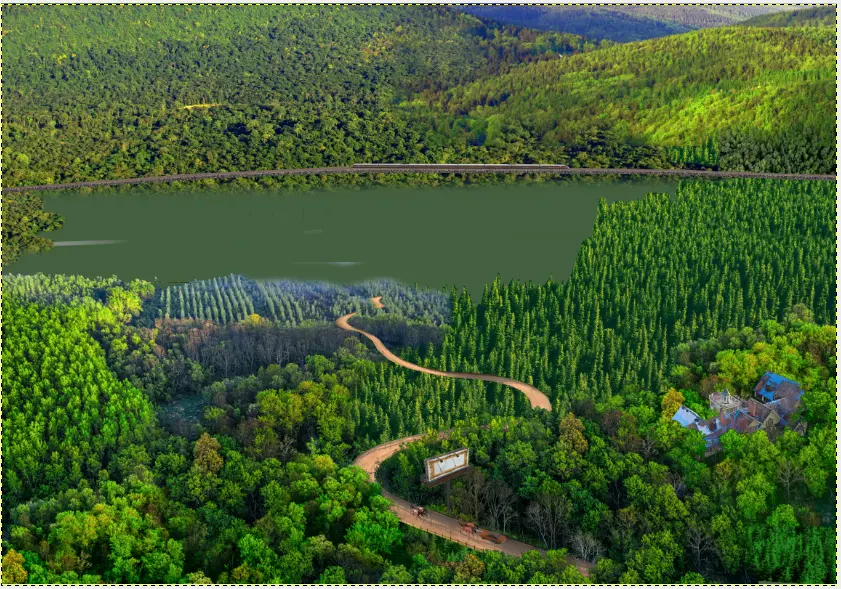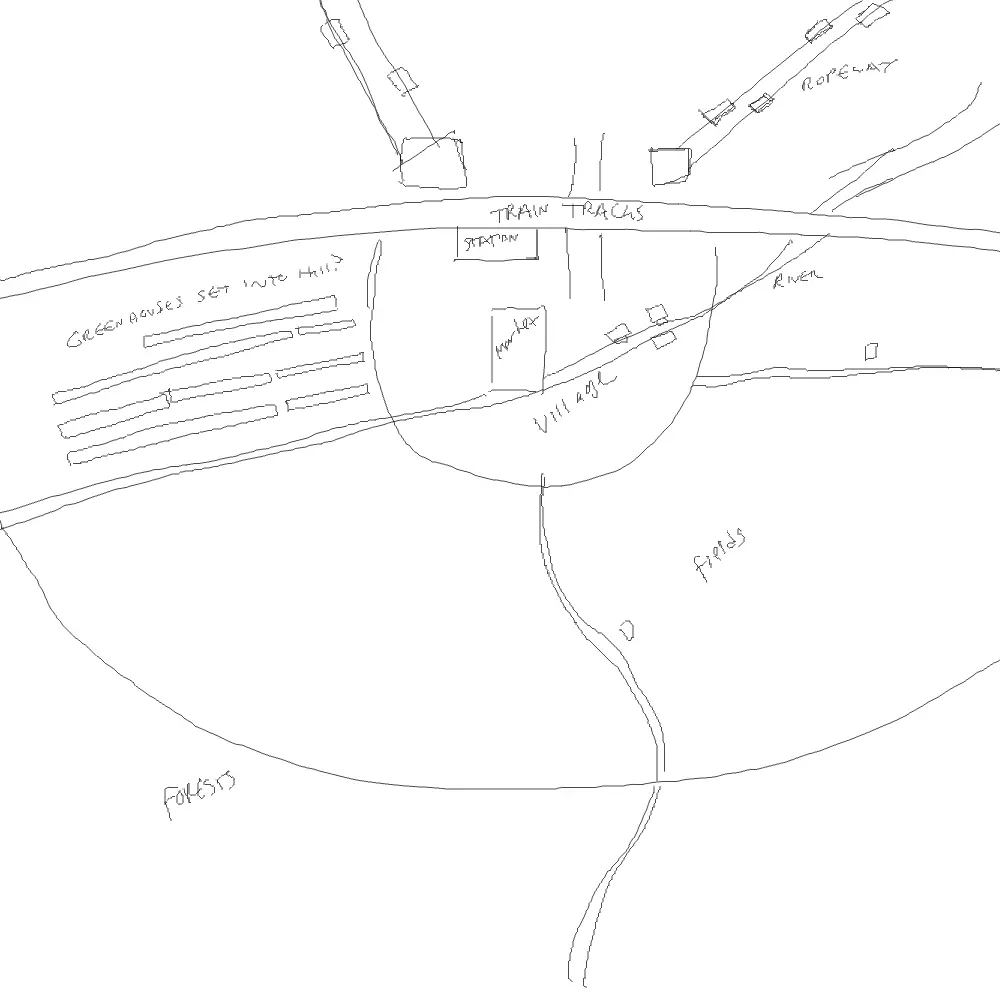Hi, recently I’ve been making these pictures/photobashes of different places in a solarpunk world, trying to demonstrate technologies or other possibilities, or values like reuse that I consider to be solarpunk. I’m working on some cityscapes but I’ve been thinking a lot about rural places since that’s where I’m from, and how they might change with some of the societal crumbles and contractions I feel like are impending. In my grandparents’ time, the region where I grew up was lots of small villages, usually bunched up around water and local industry, with farms spread out beyond that. With cars, people have spread out in these sprawling bedroom communities that are becoming ever more dense with people. Gas and groceries were 40 minutes away by car, and I feel like most people I knew drove an hour each way for work.
I wanted to do a scene sort of showing how things might change in rural areas if cars became impractical (due to shortages etc) and how things could be rebuilt better. I have a sense of what I want to include:
- Dense village surrounded by farms and forest, an abandoned mcmansion or large house far enough out to be impractical
- High speed rail access to the village
- Solar panels
- Waterwheels
- Farms
- Algae farming
For the farms, I could drop in bits and pieces of photos of farmland and make it work, I worked on a farm for a few years and feel comfortable enough for that. But I suspect folks who know more about farming, and especially folks who are into solarpunk visions of the future, might have stronger opinions on how it should be done, so I figure now is a good time to ask. What would you like to see? What should be done differently than we do now? Anything from layouts to the size of fields, to specific crops would be useful.
Edit: this’ll be in North America, by the way. (Probably northern US States though I haven’t picked one) The surrounding trees, general style of mountain, and the buildings will be based on that assumption anyways.
edit 2: here’s the current rough draft to give you an iea of the space I’m planning around
Thanks!

In northern latitudes, these kind of chinese style greenhouses that conserve heat better: https://www.motherearthnews.com/organic-gardening/chinese-greenhouses-for-winter-gardening-zm0z17amzmul/
Although the straw mats are probably better replaced with bubble foam insulation like this: https://smallfarms.cornell.edu/2011/10/soap-bubbles-to-insulate-greenhouses-a-new-approach-to-energy-conservation/
I never thought about it, but yeah, turns out greenhouses as I know them are a really good example of the one-size-fits-all approach to building enabled by the wealth of cheap energy we’re currently enjoying. I never really thought about how inefficient the ones I worked in were, especially in the winter. I really love these new designs. I was half expecting to find that they were dug into the ground to help regulate the temp, but it seems like the height is important to getting enough sunlight. They did say it helped to add earth berming on the west, north, and east walls, and that the fellow building one in Siberia had buried bart of it and used earth berming anywhere above ground. It’d be an interesting fit for a south-facing hill where they could get the best of both worlds
Lightweight farm robots that work with zero-tilling techniques, something like this: https://hackaday.com/2021/07/01/automate-the-farm-with-acorn/
Interesting! Tilling was one of those defaults I hadn’t thought to question. That would look very different from a distance
I’ll write something up later, been busy with farming, but your question shall not remain ignored.
Thanks! I really appreciate it!
Solarpunk farming (just one approach of many, not vegan mind you)
As promised, here’s a few lines about how farming could look in SP future.
Water
No water, no crops. Ideally, farms are built nearby water, but at some point you will need channels to get water to farms. Like Levadas, that are still used to this day. Water use is often regulated by the local community and can be point of dispute.
Other ways to transport water, pump water or draw it from wells: ram pumps, which points to water as energy source: where you have no naturally flowing water, you can store your water in higher places (natural or constructed reservoirs), for later energy harvest and irrigation. It’s already done in huge scale, but solarpunks can use smaller scales with less impact for their surroundings!
Soil
As much as others might go into the advantages of hydroponics (and it might have its applications in some settings), I’m more of a soil person. Soil is life. Or at least it should be full of life if you treat it right. What people in the Amazon did with soil, you can do at home. Hügelkultur is another mystical name for a very simple thing: Pile up your organic matter, add some shit, wait a while, plant on it. It’s just a really lazy==efficient, circular way of gardening, as many traditional people have done worldwide before they got lured into fossil fuel madness.
Mushrooms
Solarpunk farms need so many mushrooms! I’ve managed to add Turkey Tail logs to my garden beds and grew Oysters on a straw/manure mix from my horse shed. Learning to do more.
Animals
They are great, because they turn organic matter into manure for your garden. They clear and clean land in different ways - horses and sheep keep herbs low, goats and donkeys keep bushes and hedges in check, pigs clear a place completely and dig the soil, free range chickens, geese and guinea fowl do general maintenance by keeping plants short where other animals don’t go and eat ants and ticks. This system works if enough space is available for all and you can achieve a higher density by a high diversity of species.
Diversity
It’s important, it’s what makes the thing work. Monoculture in species, culture, field, forest, family, … **does not work. It’s a lie. You can however wildly mix equine, fowl and other beasts and a great number of trees, plants, fungi, microbes, mix up everything in your farm and field and garden, and it will thrive. Learn to use your diversity - some is food, some is medicine, some is bedding, some is stored sunlight … In a healthy strong biodiverse place even so-called invasives learn their place and will find their use. Nutrition might look a little different from the food pyramid. I don’t think we were ever meant to eat soo many cereals anyway, or the same cereal again and again. So big grain fields make space for smaller different grain fields with flowers in them because bees like them, and hedges and trees all around. Much more gardens, with fruit trees in them. So basically we’ve been told that the landscape is only efficient when treated in a huge scale way and homogeneized(?that even a word?), and from my current farming experience (and that of so many other people it turns out to be a lie).
Machines
Avoid, they are so noisy and the animals don’t like them. But sometimes you have to. So where no-till is not an option, you could use animal power - your equine will quickly figure out that their help is needed to grow treats or draw water, so they will not mind lending you a strong shoulder. (I’ve watched a few astonishing videos on yt about working animals left with a surprising degree of autonomy. Unfortunately a lot of what’s left of Western animal teaching traditions is military based, not working based, so it’s filled with sadistic and authoritarian shit - but I’ll keep this rant short for now, it gets too specific.
And renewables. Energy transfer as direct as possible should be the rule. Solar thermal, maybe even solar steam power, might be preferred over photovoltaics in many cases, as the tech might somewhat easier - we already use steam engines for a lot of shit, we might just boil the water in a smarter way.
Hydropower as in water mills, wind power obviously (just look at some traditional mill constructions, nice and reliable low tech. Also, there are some 19th century workshops still in working order that can be visited. Seriously, this place made me drool. Obviously we wouldn’t return to 19th century working conditions and not slave in a place like this 19 hours a day to make someone else rich. But a couple of hours service in the next town to produce a series of farm tools, I’d totally enjoy that! So, back to farming, hehe.
Landscape
Farmers need to know how the landscape works. Water runs down here and not there, wind blows a certain way, animals like to graze here in the morning, there in the evening, some places want to remain wild … people used to know these things, we have to re-learn them.
Community
A farm or some parts of a farm could work as a community setup (I guess it used to be a thing in the past considering there are still common lands, agricultural cooperatives (where some processing of harvest needs more tech than one farm can afford). A lot of farms used to work as family business, and if your family doesn’t suck that can be a neat arrangement - so in a solarpunk utopia travel between farms would be an encouraged thing, and young people might do it as part of their coming-of-age, and find a place to settle. Already exists a litte, and that’s how I started the farming lifestyle myself and so can you
Hard toil, back-breaking work all day
Nah, I don’t buy it. When you don’t have to make other people rich and when you don’t try to squeeze a profit out of your land and instead try to coexist with all creatures who are content to share a place with you, your life is rather easy. Word of caution: This does not mean you can give up your urban existence now and buy a farm - or well yes you can, but the learning and watching and setting up takes time, and current dystopian conditions limit the lengths to which you can build your paradise. Some of the above is inspired by examples from my actual farm, so it’s all based on possible things, but the entire thing describes an ideal state that could be an achievable possibility in maybe one or a few generations - as in our current state we are all noobs. I mean, I’m dependent from tech as fuck, I’m in no way self-sufficient (European way of living doesn’t really make that very easy), but I try to learn and combine the elements in a way that I can be lazy as fuck and enjoy my life - and from my feeble attempts I gather that it’s not that hard once you understand the basics.
Love this. Could you give me your animal discipline spill? I’ve never thought about it before and am intrigued.
Huh, do you mean like how do I make them behave well together? Not sure I understand
You mentioned working based vs military based in animal training. That’s what I’m referring to. Could you explain what it is and why it’s bad?
Especially about training of equines, mainly horses. A lot of the English and German riding tradition and a lot of equine sports derive from military tradition. The military used to be one of the main ‘employer’ of horses, starting with antique nobility, and the way they handled the animals was what ended up being the mainstream and academic source of knowledge at least in those countries - half-knowledge, because most of the actual horses’ life wasn’t spent anywhere near the wealthy noblemen who wrote clever books about how to train them. Military stuff is based on hierarchy and pain, plus, horses are not kept according to their nature to move freely in a herd, but separate from each other tied in bays or locked in boxes. Training is very much based on strict obedience, less on the horse thinking independently. It’s completely normalized to use mouthpieces and horseshoes and all sort of awful engineering to force the horse into unnatural positions and force unnatural duration and intensity of work.
Working equines might be trained roughly as well, but will often be more of an independent working partner, some may be able to socialize more freely with other equines, some may negotiate their daily duties with their owners. I’ve looked at quite a few videos of equines working in poor countries to figure out how I’d work my donkey - what’s the simplest working gear and how to use it. There’s quite a few animals that are underfed and overloaded, but more often than not you find pictures of them well treated and pulling a cart without headgear or other means of control - they are just doing their daily job and know what they are doing.
When I first saw it on video I was surprised, but then I also see it every time I spend time with my equines - I haven’t worked with them much (yet) but interactions with them are so civilized and they pick up things so quickly and do them happily for a snack, and they are also so polite and patient (after having learned they may only kick each other), it’s unfair to think of them as dumb beast without language and treat them like a sports equipment or a decoration. I’m only surprised not more people get injured in sports stables and such places. I have three: one horse and two donkeys. The horse has patiently suffered me being an idiot for 20 years and finally got me to understand her a little better and write these lines.
Woah, I had no idea. The nobility can be such dumbasses.
This is awesome! Thank you so much for putting it together!
Managing fertility of the soil and weeds will probably be two areas where things will change drastically.
For managing the fertility of the soil without using fossil fuel one of the most promising solution seems to be the use of ramial chipped wood (RCW or BRF in french). It act both as a mulch to prevent weeds and a fertilizer as it decompose.
It is used a by a lot of organic farmers but also industrial farmers that converted their soilless greenhouse of tomatoes plantation to soil by using this technique. They just use a lot (A LOT) of wood to maintain the same level of productivity.
Now to do this kind of farming you need to get the RCW from somewhere. This is where agroforestry become interesting, especially pollarding. By having pollard tree between the crops you get a constant supply of branches to shred directly on top of your crops without needing to transport aver a long distance.
I’d like to see this integrated into a process where the wood chips are obtained from a process where they are being produced anyway. I’m a little doubtful about modern attempts at putting a lot of energy for creating wood chips (or also biochar) sometimes with single-purpose processes. Can we use wood chips from other industries? Can we get the biochar from the wood fires in some farms and factories? Wherever they are cutting or planing wood into boards they also produce wood chips. Now I’d prefer they didn’t sell these chips off to turn them into horrible furniture plate as it’s done now - it’s not sustainable and deteriorates after a few years, whereas wood furniture can last more than a person’s lifetime. In some solarpunk future I wish every village or village-sized community had forest/trees dispersed between fields, and a saw mill that can turn them into boards, beams and wood chips - I’d rather not travel further than a few km, and also don’t want to cut my own wood and chips (I’m old and tired).
That’s a really cool way to do things! The pollarded trees are very distinctive and should show up well even at a distance. and I like how self-contained this layout seems to be. I’ll have to build the fields out of individual bits and pieces since I’m pretty sure I won’t be able to find aerial photos of a suitable field at the right angle, but it’ll give me a chance to make sure I have the details right.
I’ve started reading up on agroforestry and on Nitrogen-fixing Trees (the far-superior NFTs) and definitely plan to try and make this work. Do you have any recommendations on field size, layout (it sounds like alley-cropping is probably the most common fit in use in the US, but I’m happy to explore other options - some places seem to do straight rows, some do squiggly, irregular ones and I’m not sure why yet. I’m not sure yet what makes the best sense and what will be the most clear visually at this distance) or crops? It’s tough because I want to make sure it’s somewhat realistic for agroforestry but I also want to make sure I’m providing enough food and variety for the village to be somewhat self-sufficient, though there’s a train and this is all going to be pretty tiny anyways so I suppose it’s not a huge deal. I’m also looking at including some kind of algae farming and greenhouses, if there’s any way that could be copacetic with agroforestry I’d be happy to mix them up.
At the moment, my plans go about this far:


I figure the village will probably have some fruit trees inside it, along with taller trees for shade. I might move the river south to show they’re in a pretty dry spot. I can adjust the topology pretty easily but I’d like to have at least some of the chinese-style greenhouses provoq mentioned set on (or into, for bonus temperature regulation) a hill. Outside of that, I can do whatever makes sense. lots of squiggly rows of trees and crops or tiny herd animals between them? straight rows? I’m not sure how organized the fields should look but my instinct is to make some obvious property boundaries and make it look like several different farms occupying the land. not sure how solarpunk that is
Thanks again for the suggestions!
For the village, you can have at what they did in this french village for inspiration:
https://youtu.be/TDbH_s0vvkI?si=KngLjiaoqzzt7hqv&t=2770
There is a greenhouse and fields at the center of village that produces all the vegetable used by the local school for school lunch. The workers for the field are employed directly by the village.
There is few aerial view in the video.
Just watched it, thanks!




